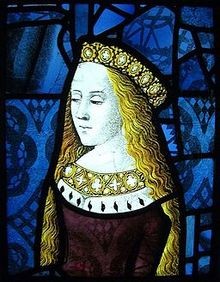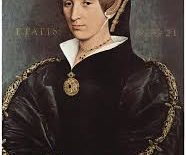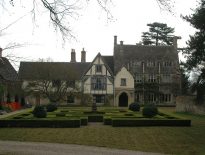 Cecily of York was the third daughter of the first Yorkist king, Edward IV, and his consort Elizabeth Wydeville (Woodville). She was born on 20 March 1469 at Westminster Palace in London. At the age of five, on 26 October 1474, the princess was betrothed to James, son of James III of Scotland, as a means of achieving an alliance between the traditionally warring kingdoms of England and Scotland. This betrothal ultimately came to nothing when Anglo-Scottish relations worsened to the extent that Edward IV prepared for an invasion of the neighbouring realm. Three years later, when Cecily was fourteen years of age, Edward died at Westminster. Cecily’s brother Edward was subsequently proclaimed king, but their uncle Richard of Gloucester seized the throne, and both Edward and their younger brother Richard were taken to the Tower of London. What became of the two ‘Princes in the Tower’ has never been revealed.
Cecily of York was the third daughter of the first Yorkist king, Edward IV, and his consort Elizabeth Wydeville (Woodville). She was born on 20 March 1469 at Westminster Palace in London. At the age of five, on 26 October 1474, the princess was betrothed to James, son of James III of Scotland, as a means of achieving an alliance between the traditionally warring kingdoms of England and Scotland. This betrothal ultimately came to nothing when Anglo-Scottish relations worsened to the extent that Edward IV prepared for an invasion of the neighbouring realm. Three years later, when Cecily was fourteen years of age, Edward died at Westminster. Cecily’s brother Edward was subsequently proclaimed king, but their uncle Richard of Gloucester seized the throne, and both Edward and their younger brother Richard were taken to the Tower of London. What became of the two ‘Princes in the Tower’ has never been revealed.
Cecily remained in sanctuary at Westminster with her mother and sisters until March 1484, when the dowager queen agreed terms with Richard. The king promised to marry each of Elizabeth Wydeville’s daughters to gentlemen, providing each with two hundred marks per annum in land. Cecily was subsequently married to Ralph Scrope, who was four years or so older than her. When Henry Tudor took the throne as Henry VII in 1485, the match was dissolved, and Cecily was married to the king’s half-uncle John Welles, Viscount Welles. It was hardly a splendid marriage for a Yorkist princess, but it was in keeping with Henry’s modest policies towards his Yorkist in-laws. Cecily’s sister Elizabeth had married the Tudor king and the viscountess featured in court occasions, including the christening of her nephew, Prince Arthur. She bore her sister’s train at Elizabeth of York’s coronation on 25 November 1487.
It is impossible to reconstruct whether Cecily’s relations with her husband were amicable. They had two daughters together, Elizabeth and Anne. A marriage was arranged in 1498 between Elizabeth and the heir of George Stanley, Lord Strange, but Elizabeth died that year. Her sister Anne died the following year. The viscount himself died on 9 February 1499, leaving Cecily a widow at thirty years of age. She was provided with a life interest in his lands, but this arrangement proved short-lived when Cecily remarried three years later. Her second husband was Thomas Kyme, a Lincolnshire esquire. His humble status indicates that theirs may have been a love match. The king was furious with his sister-in-law, and her Welles estates were seized. The king’s mother Lady Margaret Beaufort assisted Cecily and her husband, and an arrangement was devised whereby Cecily renounced some of the Welles' land in return for a life interest in the remainder. There is no evidence that Cecily had children with her second husband. She died at Hatfield on 24 August 1507 at the age of thirty-eight, a relatively obscure end for a princess of the house of York.
Conor Byrne is the author of Katherine Howard: A New History and Queenship in England: 1308–1485 Gender and Power in the Late Middle Ages. He is a British graduate with a degree in History from the University of Exeter. Conor has been fascinated by the Tudors, medieval and early modern history from the age of eleven, particularly the lives of European kings and queens. His research into Katherine Howard, fifth consort of Henry VIII of England, began in 2011-12, and his first extended essay on her, related to the subject of her downfall in 1541-2, was written for an Oxford University competition. Since then Conor has embarked on a full-length study of Queen Katharine's career, encompassing original research and drawing on extended reading into sixteenth-century gender, sexuality and honour. Some of the conclusions reached are controversial and likely to spark considerable debate, but Conor hopes for a thorough reassessment of Katherine Howard's life. Conor runs a historical blog which explores a diverse range of historical topics and issues. He is also interested in modern European, Russian, and African history, and, more broadly, researches the lives of medieval queens, including current research into the defamed 'she-wolf' bride of Edward II, Isabella of France.
Conor has just completed his Masters.
Picture: Cecily in stained glass, probably 1482–83, formerly Canterbury Cathedral, now Burrell Collection, Wikipedia.



Very informative article, but I assume you mean, Richard, their uncle, not father took the crown.
I enjoyed this balanced article because so much has been written in nonsense fiction recently making Princess Cecily of York out to be something of a wh*re and adulteress, which of course is nonsense.
Hi RealTudorLady,
Where are you seeing “father”? The article did have an error in it but it was fixed on the same day it was posted after a member emailed me to let me know. I can’t see the error now and so am concerned that you can still see it. Have I missed a place? Please let me know. Thanks so much.
No, it is correct now. It did say father, but it must have been just before it was corrected, or I put too much whisky in my hot toddy. Never mind, it says uncle, now.
That’s so weird but a hot toddy sounds nice, are you suffering?
I think I might have figured it out. It was probably in the excerpt that was part of the Tudor Society round-up email. That is done automatically and it probably took the original post excerpt. Ah ha! Got it! Glad I’m not going mad…
Hi, no I do have a sinus infection which I have had treatments for but have stayed clear of the flue. I have a hot toddy against the cold as it has been very chilly the last few nights or so. I had a telephone call with our cousins in South Africa on Sunday and they are having a very hot heat wave so I asked them to post some back to the U.K. lol.
Yes, I may have opened it from the email. You’re not going mad. This is the first really good article on Cecily of York I have read. A series of books came out in fiction recently which made her out as a wh*re and adulteress which although I didn’t read them, the reviews were enough. There are no books on the sisters or daughters of Edward iv apart from Margaret and of course, Queen Elizabeth of York. I have been trying to research Anne but it is like starting from scratch. The only book I know is by Jean Plaidy. No biography but of course John Ashdown Hill researched her as she had the all female DNA he needed to identify Richard iii. Cecily fascinates me but a biography is badly needed. Thanks for hosting this article on behalf of Conor Bryne, another success.
Oh no, how horrible! I hope you feel better soon.
Yes, that’s true, there are so many women from that period of history who seem to have been forgotten.
Thanks, yes it is getting better.
Cheers
weird that conor stated that she didn’t have kids in her 2nd marriage when it should be the the 3rd. after all henry viii dissolved 4 marriages, but he’s said to have married 6 times.
also, wiki has weird info which states info about her “two kids” and their descendants, ect. wiki quotes alison weir and i read the page from archive.org. weir states taht her kids richard and agnes married (list of spouse names) and said they had issue. she also states she said the info is suspect since it came in 1602.
i think she didn’t have kids w/her latest hubby. the most likely scenario.